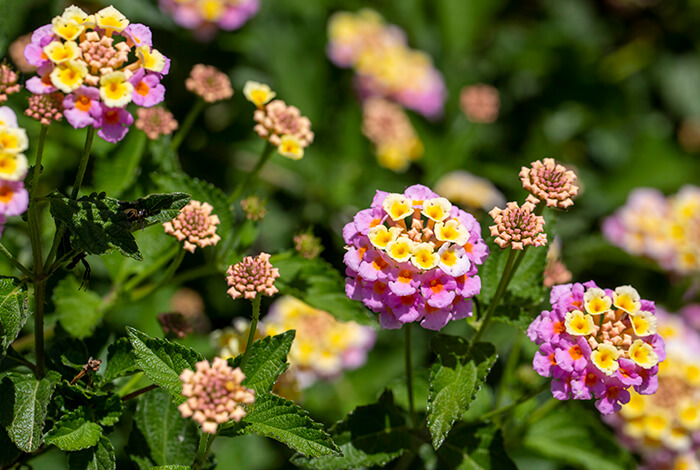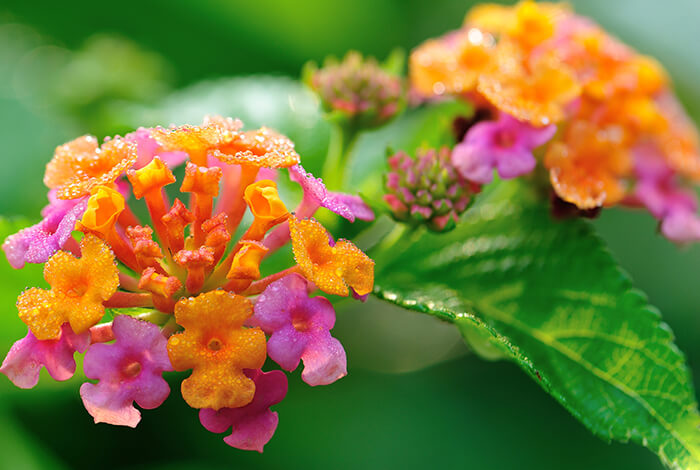Is lantana poisonous to dogs? Lantana is poisonous to dogs and can cause life-threatening adverse effects when ingested, such as organ damage.
Learn what makes this plant dangerous to your canine friend and how to handle lantana toxicity.
Why Is Poisonous to Dogs?
 Lantana camara or lantana is known by other names, including common lantana, red sage, shrub verbena, and yellow sage. The toxic properties identified in this plant are pentacyclic triterpenoids called lantadene A & B.
Lantana camara or lantana is known by other names, including common lantana, red sage, shrub verbena, and yellow sage. The toxic properties identified in this plant are pentacyclic triterpenoids called lantadene A & B.
These compounds are observed to be gastrointestinal irritants and hepatotoxic. If your canine companion ingests lantana, he will suffer from stomach upset and liver damage.
The latter side effect occurs because toxic triterpenoids trigger the accumulation of excessive fat deposits in the liver. It impedes the organ’s function, causing it to become inflamed and swollen.
Lantana poisoning-induced liver damage in dogs is also known to cause secondary photosensitization. Hence, growing this plant in a household with dogs is highly discouraged.
What Parts of the Lantana Are Poisonous in Dogs?
Only certain parts of the lantana plant are toxic to dogs, namely the:
- Berries
- Flowers
- Leaves
- Sap
The highest concentrations of pentacyclic triterpenoids are found in lantana’s foliage and berries. Some people state that ripened berries do not pose toxic dangers, but there is no concrete evidence for these claims.
Due to this, unripe berries are more likely to trigger severe adverse reactions compared to ripened ones.
Although the stems and roots of the lantana plant are not toxic to dogs, they should not be ingested. Consuming them may result in stomach obstruction because they are highly fibrous and difficult to digest.
How Poisonous Is the Lantana Plant to Dogs?
 The pet poison helpline classifies the lantana as moderately poisonous to canines. Unlike plants with low toxicity, only a few bites of lantana, especially its leaves and berries, will induce fatal health problems.
The pet poison helpline classifies the lantana as moderately poisonous to canines. Unlike plants with low toxicity, only a few bites of lantana, especially its leaves and berries, will induce fatal health problems.
On the brighter side, dogs typically rarely consume this plant in large amounts. In most cases, the adverse reactions that take place are gastrointestinal issues.
What Are Common Clinical Signs of Lantana Poisoning to Dogs?
Ingestion of lantana can induce the following symptoms in canines:
- Inappetence
- Vomiting
- Diarrhea
- Excessive weight loss
- Depression
- Increased urination
Severe forms of lantana toxicity trigger these clinical signs:
- Swollen abdomen
- Breathing difficulty
- Body incoordination
- Liver failure
- Shock
Affected dogs may also develop photosensitivity, which makes their skin vulnerable to the sun’s ultraviolet rays. Exposure to it can lead to the manifestation of itchy rashes or blisters and inflamed, swollen skin.
In general, it takes around 24 hours for initial symptoms of lantana poisoning in dogs to appear. Large consumption of this plant may result in death within 2 to 4 days.
Thus, taking swift action is critical in ensuring that they receive proper treatment and have a good prognosis.
What To Do If Your Dog Ate a Lantana Plant?

If you caught your dog chewing on a lantana, keep him away from the plant. Then take note of important details that will aid in providing appropriate medical treatment to your dog, such as:
- Which parts of the toxic plant did your furry pal ingest?
- How much of the plant did he manage to consume?
- Around what time did he ingest the lantana?
- Is your canine companion showing symptoms of poisoning?
When you are done collecting this information, get a sample of the plant and take it with you to the animal clinic.
The vet will examine it during diagnosis to rule out potential health issues and determine the cause of adverse reactions if your dog is already exhibiting them.
How Does the Vet Treat Lantana Poisoning in Dogs?

The veterinarian will administer active charcoal to dogs with lantana poisoning. It binds with the toxins in the system, preventing their absorption into the body.
Frequent vomiting and diarrhea gradually cause dehydration. To mitigate this health problem, dogs will be given intravenous fluids to avoid further electrolyte and water loss.
They will also receive medications like antinausea and anti-inflammatory drugs to reverse adverse reactions.
FAQs About Is Lantana Poisonous to Dogs?
1. Is Lantana Toxic to Cats and Dogs?
Lantana is toxic to both cats and dogs. Thus, if you also own a feline companion, avoid keeping this plant in your home.
Ingesting lantana causes the same set of adverse reactions in cats, including GI upset, photosensitivity, and liver problems.
2. How Poisonous Are Lantanas?
Lantanas are identified to be moderately toxic to dogs. This means it does not take much for this plant to cause serious poisoning in canines.
Keep in mind that some parts of the plant are more toxic than others, specifically the leaves and fruits. Thus, make sure that your canine companion does not have access to any of them.
3. What Are the Most Negative Effects of Lantana on Dogs?
The most negative effects of lantana on dogs are liver damage and failure. These health complications happen because of the hepatoxic properties of pentacyclic triterpenoids found in the plant.
These chemical compounds cause too much fat accumulation in the liver, leading to swelling and inflammation. Without timely treatment, the liver may sustain significant and irreversible damage, which causes it to shut down.
4. Does Lantana Poisoning in Dogs Go Away on Its Own?
Most cases of lantana poisoning in dogs are mild, with the most common adverse effects being vomiting and diarrhea. They are often temporary and disappear within a few days.
However, it is not a good idea to ignore these clinical signs since they might be caused by a different underlying illness.
If you think treating him at home is the best course of action, consult with the veterinarian first. Getting their opinion will help you choose the best solution for your pet’s condition.
Make sure to keep a close eye on your dog for at least 1 to 2 days if the vet decides that you do not need to bring him to the animal clinic.
Occurrence of severe symptoms like abdominal swelling and labored breathing requires an immediate trip to the vet.
Conclusion

Is lantana poisonous to dogs? Lantana is poisonous to dogs due to the pentacyclic triterpenoids it produces. The highest concentrations of these compounds can be found in the leaves and berries of the plant.
If ingested in moderate to large amounts, adverse reactions like vomiting, diarrhea, and liver damage may take place. For this reason, it would be wise to avoid growing a lantana plant in your home if you have a canine companion.

